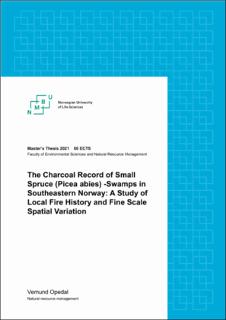| dc.description.abstract | The local fire history of a Norway spruce (Picea abies) forest with a high present-day biodiversity has been investigated to explore the spatiotemporal fire dynamics of a delimited part of Trillemarka Nature Reserve in southeastern Norway. The fire history of the nearby pine forest has previously been studied in detail revealing numerous fires the last 600 years. This study investigated if the adjacent spruce forest has burnt after spruce established and became abundant in the area, and if this changed the local fire regime. In addition, the fine scale spatial variation of the charcoal records was analyzed. Visible charcoal bands with macroscopic charcoal particles (>0,5 mm) were extracted from peat sequences from 12 closed-canopy spruce-swamps and three open Scots pine (Pinus sylvestris) dominated mires. Six peat sequences were extracted at each site, plus an additional sequence at eight sites for pollen analysis and 14C dating.
In total, 249 charcoal bands with macroscopic charcoal were identified illuminating the local fire history covering the last 3000 years in most sites. All sites contained charcoal, but the number of bands and amount of charcoal particles varied greatly between and within sites. Overall, 24 % of the sequences did not contain any macroscopic charcoal, which demonstrates the extensive fine scale spatial variation of charcoal in the peat. The average number of charcoal bands per sequence was 2,2 SD 2,2 and the average number of macroscopic charcoal particles per sequence was 231 SD 210. The amount of charcoal particles increased with the length of the sequence and were mostly found in the lower end of the sequences. Based on pollen analysis it was concluded that spruce established around 900-1100 AD, and 66 % of the spruce dominated sites contained charcoal bands after spruce establishment, which gave an average of 2,2 local fire events in each site. Thus, most of the spruce dominated sites have burnt at some point, although with major spatial variation. In one part of the spruce forest, fire activity seemingly ceased after spruce establishment, whereas the fire frequency increased or remained stable in other parts. The high fire frequency in some sites the last millennia could possibly be attributed to anthropogenic activities. More charcoal bands were found in the spruce dominated sites than the pine dominated sites during the same period, suggesting higher probability of detecting local fires events in the peat of the small spruce-swamp hollows than the pine-mires. | en_US |

